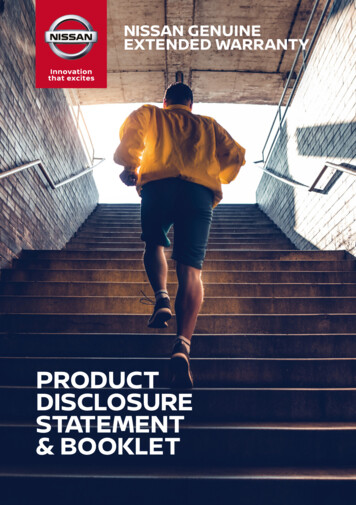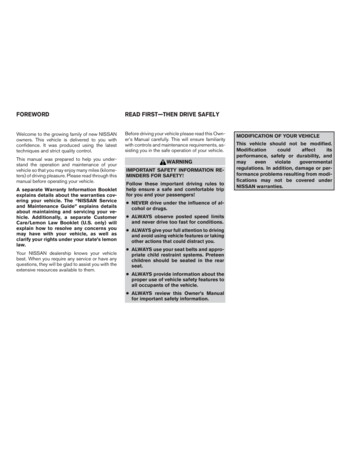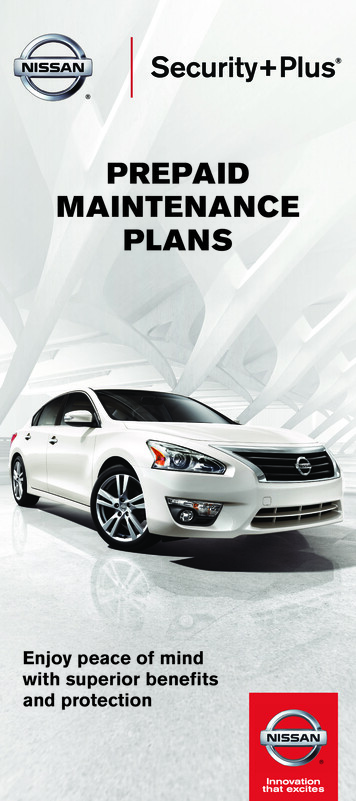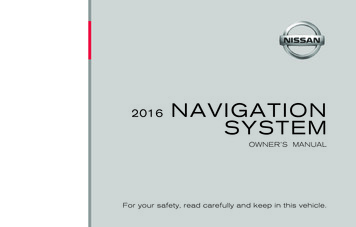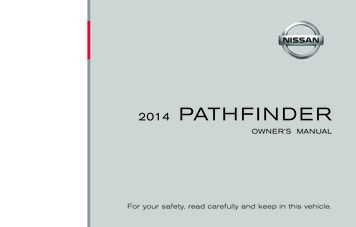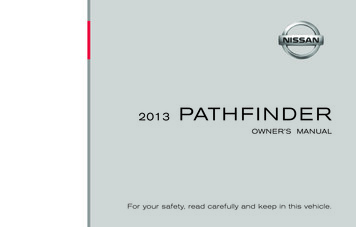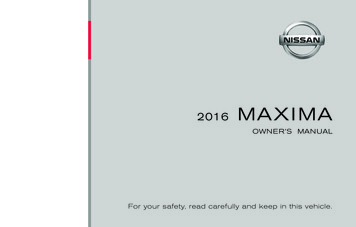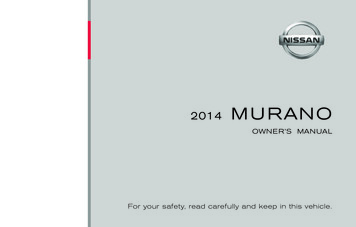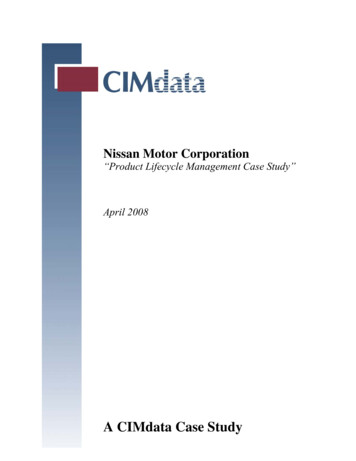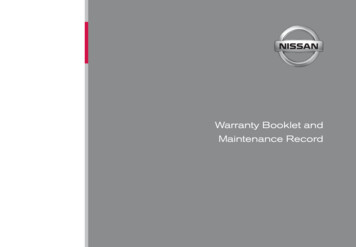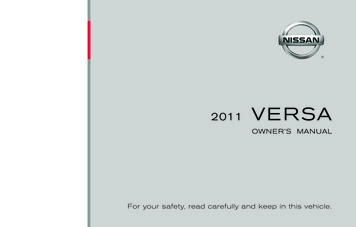
Transcription
2011VE R SAOWNER’S MANUALFor your safety, read carefully and keep in this vehicle.
FOREWORDWelcome to the growing family of new NISSANowners. This vehicle is delivered to you withconfidence. It was produced using the latesttechniques and strict quality control.This manual was prepared to help you understand the operation and maintenance of yourvehicle so that you may enjoy many miles (kilometers) of driving pleasure. Please read through thismanual before operating your vehicle.READ FIRST—THEN DRIVE SAFELYIn addition to factory installed options, your vehicle may also be equipped with additional accessories installed by Nissan or by your authorized Nissan dealer prior to delivery. It is importantthat you familiarize yourself with all disclosures,warnings, cautions and instructions concerningproper use of such accessories prior to operatingthe vehicle and/or accessory. Please see yourdealer for details concerning the particular accessories with which your vehicle is equipped.Before driving your vehicle, please read thisOwner’s Manual carefully. This will ensure familiarity with controls and maintenance requirements, assisting you in the safe operation of yourvehicle.WARNINGIMPORTANT SAFETY INFORMATION REMINDERS FOR SAFETY!A separate Warranty Information Bookletexplains details about the warranties covering your vehicle. The “NISSAN Serviceand Maintenance Guide” explains detailsabout maintaining and servicing your vehicle. Additionally, a separate CustomerCare/Lemon Law Booklet (U.S. only) willexplain how to resolve any concerns youmay have with your vehicle, as well asclarify your rights under your state’s lemonlaw.Follow these important driving rules tohelp ensure a safe and comfortable tripfor you and your passengers!Your NISSAN dealership knows your vehiclebest. When you require any service or have anyquestions, they will be glad to assist you with theextensive resources available to them. ALWAYS use your seat belts and appropriate child restraint systems. Preteenchildren should be seated in the rear seat. NEVER drive under the influence of alcohol or drugs. ALWAYS observe posted speed limitsand never drive too fast for conditions. ALWAYS give your full attention to drivingand avoid using vehicle features or takingother actions that could distract you. ALWAYS provide information about theproper use of vehicle safety features toall occupants of the vehicle. ALWAYS review this Owner’s Manualfor important safety information.
WHEN READING THE MANUALMODIFICATION OF YOUR VEHICLEThis vehicle should not be modified.Modificationcouldaffectitsperformance, safety or durability, andmayevenviolategovernmentalregulations. In addition, damage or performance problems resulting from modifications may not be covered underNISSAN warranties.This manual includes information for all optionsavailable on this model. Therefore, you may findsome information that does not apply to yourvehicle.All information, specifications and illustrations inthis manual are those in effect at the time ofprinting. NISSAN reserves the right to changespecifications or design without notice and without obligation.IMPORTANT INFORMATION ABOUTTHIS MANUALYou will see various symbols in this manual. Theyare used in the following ways:WARNINGThis is used to indicate the presence of ahazard that could cause death or seriouspersonal injury. To avoid or reduce therisk, the procedures must be followedprecisely.APD1005If you see this symbol, it means “Do not do this”or “Do not let this happen.”If you see a symbol similar to these in an illustration, it means the arrow points to the front of thevehicle.CAUTIONThis is used to indicate the presence of ahazard that could cause minor or moderate personal injury or damage to your vehicle. To avoid or reduce the risk, the procedures must be followed carefully.Arrows in an illustration that are similar to theseindicate movement or action.Arrows in an illustration that are similar to thesecall attention to an item in the illustration.
CALIFORNIA PROPOSITION 65WARNINGWARNINGEngine exhaust, some of its constituents,and certain vehicle components containor emit chemicals known to the State ofCalifornia to cause cancer and birth defects or other reproductive harm. In addition, certain fluids contained in vehiclesand certain products of component wearcontain or emit chemicals known to theState of California to cause cancer andbirth defects or other reproductive harm.CALIFORNIA PERCHLORATEADVISORYSome vehicle parts, such as lithium batteries, may contain perchlorate material. Thefollowing advisory is provided: “PerchlorateMaterial – special handling may apply, BLUETOOTH威 is atrademark owned byBluetooth SIG, Inc.,U.S.A. and licensedto Xanavi InformaticsCorporation.XM Radio威 requiressubscription, soldseparately. Notavailable in Alaska,Hawaii or Guam.For moreinformation, visitwww.xmradio.com. Nissan Mexicana, S. A. de C. V.All rights reserved. No part of this Owner’sManual may be reproduced or stored in a retrievalsystem, or transmitted in any form, or by anymeans, electronic, mechanical, photocopying,recording or otherwise, without the prior writtenpermission of Nissan Mexicana, S. A. de C. V.
NISSAN CUSTOMER CARE PROGRAMNISSAN CARES . . .Both NISSAN and your NISSAN dealer are dedicated to serving all your automotive needs. Your satisfaction with your vehicle and your NISSAN dealer areour primary concerns. Your NISSAN dealer is always available to assist you with all your automobile sales and service needs.However, if there is something that your NISSANdealer cannot assist you with or you would like toprovide NISSAN directly with comments orquestions, please contact the NISSAN Consumer Affairs Department using our toll-freenumber:For U.S. customers1-800-NISSAN-1(1-800-647-7261)For Canadian customers1-800-387-0122The Consumer Affairs Department will ask for thefollowing information:– Your name, address, and telephone number– Vehicle identification number (attached to thetop of the instrument panel on the driver’sside)– Date of purchase– Current odometer reading– Your NISSAN dealer’s name– Your comments or questionsORYou can write to NISSAN with the information at:For U.S. customersNissan North America, Inc.Consumer Affairs DepartmentP.O. Box 685003Franklin, TN 37068-5003For Canadian customersNissan Canada Inc.5290 Orbitor DriveMississauga, Ontario L4W 4Z5or via e-mail at:For U.S. customersnnaconsumeraffairs@nissan-usa.comFor Canadian customersinformation.centre@nissancanada.comWe appreciate your interest in NISSAN and thank you for buying a quality NISSAN vehicle.
Table ofContentsIllustrated table of contents0Safety—Seats, seat belts and supplemental restraint system1Instruments and controls2Pre-driving checks and adjustments3Display screen, heater, air conditioner, audio and phone systems4Starting and driving5In case of emergency6Appearance and care7Maintenance and do-it-yourself8Technical and consumer information9Index10
0 Illustrated table of contentsAir bags, seat belts and child restraints . . . . . . . . . . . . . . 0-2Exterior front . . . . . . . . . . . . . . . . . . . . . . . . . . . . . . . . . . . . . . 0-3Exterior rear. . . . . . . . . . . . . . . . . . . . . . . . . . . . . . . . . . . . . . . 0-4Passenger compartment . . . . . . . . . . . . . . . . . . . . . . . . . . . 0-6Instrument panel. . . . . . . . . . . . . . . . . . . . . . . . . . . . . . . . . . . 0-7Engine compartment check locations . . . . . . . . . . . . . . . . 0-9Warning/indicator lights . . . . . . . . . . . . . . . . . . . . . . . . . . . 0-11
AIR BAGS, SEAT BELTS AND CHILDRESTRAINTS1. Supplemental front-impact air bagmodules (P. 1-41)2. Roof-mounted curtain side-impactsupplemental air bag (P. 1-41)3. Front seat-mounted side-impactsupplemental air bag (P. 1-41)4. Front seat belts (P. 1-12)5. Head Restraints (P. 1-6)6. Rear seat belts (P. 1-12)7. LATCH (Lower Anchors and Tethers forCHildren) system (P. 1-24)8. Seat belt with pretensioner (P. 1-54)9. Seats (P. 1-2)10. Occupant classification sensor(pressure sensor) (P. 1-41)See the page number indicated in parentheses for operating details.WII01570-2 Illustrated table of contents
EXTERIOR FRONT1.2.3.4.5.6.7.8.9.10.11.12.13.14.Engine hood (P. 3-22)Windshield wiper and washer switch(P. 2-19)Windshield (P. 8-21)Moonroof (if so equipped) (P. 2-34)Power windows (if so equipped)(P. 2-31)Door locks, keyfob (if so equipped),NISSAN Intelligent Key (if soequipped), keys (P. 3-4, 3-7, 3-2, 3-2)Mirrors (P. 3-30)Tire pressure (P. 8-36)Flat tire (P. 6-2)Tire chains (P. 8-43)Headlight and turn signal switch(P. 2-21)Replacing bulbs (P. 8-31)Fog light switch (if so equipped)(P. 2-21)Tie down hook (P. 6-13)See the page number indicated in parentheses for operating details.WII0178Illustrated table of contents 0-3
EXTERIOR REARHatchback1.2.3.4.5.6.7.8.9.Rear hatch opener s witch/NISSANIntelligent Key (if so equipped)(P. 3-23, 3-13)Rear window defroster switch (P. 2-20)Antenna (P. 4-54)Child safety rear door locks (P. 3-7)Fuel-filler door (P. 3-26)Fuel-filler cap, fuel recommendation(P. 3-27, 9-4)Replacing bulbs (P. 8-31)Interior hatch release (P. 3-24)Rear window washer (P. 2-20)See the page number indicated in parentheses for operating details.WII00930-4 Illustrated table of contents
Sedan1.2.3.4.5.6.7.8.Interior trunk lid release (P. 3-26 )Rear window defroster switch (P. 2-20)Antenna (P. 4-54)Child safety rear door locks (P. 3-7)Fuel-filler door (P. 3-26)Fuel-filler cap, fuel recommendation(P. 3-27, 9-4)Replacing bulbs (P. 8-31)Trunk opener switch/NISSAN IntelligentKey (if so equipped) (P. 3-24 / 3-13)See the page number indicated in parentheses for operating details.WII0102Illustrated table of contents 0-5
PASSENGER COMPARTMENT1.Cargo cover (if so equipped)(hatchback model only) (P. 2-29)2. Rear seat (P. 1-4)3. Interior lights (P. 2-36)4. Front seat (P. 1-2)5. Sun visors (P. 3-29)6. Moonroof switch (if so equipped)(P. 2-34)7. Map lights (if so equipped) (P. 2-36)8. Sunglasses holder (if so equipped)(P. 2-27)9. Glove box (P. 2-28)10. Parking brake, parking on hills(P. 5-24, 5-28)11. Rear armrest (if so equipped) (P. 1-5)See the page number indicated in parentheses for operating details.LII00830-6 Illustrated table of contents
INSTRUMENT PANEL6.7.8.9.10.11.12.13.14.15.WIC15991.2.Outside mirror control switch(if so equipped) (P. 3-31)Headlight/fog light (if so equipped)/turnsignal switch (P. 2-21)3.4.5.Steering wheel switch for audio controland Bluetooth姞 Hands-Free PhoneSystem (if so equipped) (P. 4-53, 4-56)Driver’s supplemental air bag/horn(P. 1-41, 2-24)Meters and gauges (P. 2-3)16.17.18.19.20.21.22.23.24.25.26.Cruise control main/set switches(if so equipped) (P. 5-25)Windshield wiper/washer switch(P. 2-19, 2-20)Audio system (if so equipped) (P. 4-17)Covered storage bin (P. 2-25)/iPod姞outlet (if so equipped) (P. 4-47)/USBinterface (if so equipped) (P. 4-51)Center ventilator (P. 4-8)Hazard warning flasher switch (P. 2-23)Passenger’s supplemental air bag(P. 1-41)Glove box (P. 2-28)Side ventilator (P. 4-8)Navigation system* (if so equipped)(P. 4-2)Cup holders (P. 2-27)Shift selector (P. 5-14)Defroster switch (P. 2-20)Climate control (P. 4-9)Passenger air bag status light (P. 1-49)Ignition switch (P. 5-7)Tilt steering (P. 3-29)Instrument brightness control (P. 2-22)Hood release lever (P. 3-22)Fuel-filler lid release lever (P. 3-26)Fuse block (P. 8-24)Illustrated table of contents 0-7
27.Vehicle Dynamic Control (VDC) offswitch (if so equipped) (P. 2-24)*:Refer to the separate Navigation System Owner’s Manual (if so equipped).See the page number indicated in parentheses for operating details.0-8 Illustrated table of contents
ENGINE COMPARTMENT CHECKLOCATIONSHR16DE1.2.Engine oil filler cap (P. 8-10)Brake and clutch (*1) fluid reservoir(P. 8-15)3. Air cleaner (P. 8-21)4. Battery (P. 8-17)5. Fuse/fusible link box (P. 8-24)6. Automatic transmission fluid (ATF)dipstick (*2) (P. 8-14)7. Radiator cap (P. 8-8)8. Engine coolant reservoir (P. 8-8)9. Engine oil dipstick (P. 8-10)10. Drive belt location (P. 8-19)11. Windshield-washer fluid reservoir(P. 8-16)*1 For Manual Transmission (M/T) model*2 For Automatic Transmission (A/T)modelSee the page number indicated in parentheses for operating details.WDI0715Illustrated table of contents 0-9
MR18DE1.2.Engine oil filler cap (P. 8-10)Brake and clutch (*1) fluid reservoir(P. 8-15)3. Air cleaner (P. 8-21)4. Battery (P. 8-17)5. Fuse/fusible link box (P. 8-24)6. Automatic/Continuously variabletransmission fluid (ATF) dipstick (*2)(P. 8-14)7. Radiator cap (P. 8-8)8. Engine oil dipstick (P. 8-10)9. Engine coolant reservoir (P. 8-8)10. Drive belt location (P.8-19)11. Windshield-washer fluid reservoir(P. 8-16)*1 For Manual Transmission (M/T) model*2 For Automatic Transmission (A/T)model/Continuously VariableTransmission (CVT) modelSee the page number indicated in parentheses for operating details.WDI07330-10 Illustrated table of contents
WARNING/INDICATOR LIGHTSWarninglightorNamePageAnti-lock BrakingSystem (ABS) warning light (if soequipped)2-8Brake warning light2-8orCharge warning light2-9Door open warninglight2-9Electric powersteering warninglight2-9Engine oil pressurewarning light2-10WarninglightNamePageHigh temperaturewarning light (red)2-10Low fuel warninglight2-10Low tire pressurewarning light (if soequipped)2-10Low windshieldwasher fluid warninglight (if so equipped)2-11NISSAN IntelligentKey lock warninglight (M/T models) (ifso equipped)2-11NISSAN IntelligentKey warning light(if so equipped)2-12WarninglightIndicatorlightNamePageP position selectingwarning light (formodels withNISSAN IntelligentKey ) (if soequipped)2-12Seat belt warninglight and chime2-12Supplemental airbag warning light2-12NamePageAutomatic Transmission (A/T) / Continuously VariableTransmission (CVT)position indicatorlight (if so equipped)2-13Illustrated table of contents 0-11
IndicatorlightNamePageCruise main switchindicator light (if soequipped)2-13Cruise set switchindicator light (if soequipped)2-13Front passenger airbag status light2-13High beam indicatorlight (blue)2-13Low temperatureindicator light (blue)2-13Malfunction Indicator Light (MIL)2-14Overdrive OFF indicator light (A/T /CVT models)2-140-12 Illustrated table of contentsIndicatorlightNamePageSecurity indicatorlight2-14Slip indicator light (ifso equipped)2-15Turn signal/hazardindicator lights2-15Vehicle DynamicControl (VDC) offindicator light (if soequipped)2-15
1 Safety—Seats, seat belts andsupplemental restraint systemSeats . . . . . . . . . . . . . . . . . . . . . . . . . . . . . . . . . . . . . . . . . . . . 1-2Front manual seat adjustment . . . . . . . . . . . . . . . . . . . . 1-2Folding rear seat (if so equipped). . . . . . . . . . . . . . . . . 1-4Head restraints (Hatchback model and frontseats of Sedan model) . . . . . . . . . . . . . . . . . . . . . . . . . . 1-6Adjustable headrest(rear seats for Sedan model). . . . . . . . . . . . . . . . . . . . . 1-9Seat belts . . . . . . . . . . . . . . . . . . . . . . . . . . . . . . . . . . . . . . . 1-12Precautions on seat belt usage. . . . . . . . . . . . . . . . . . 1-12Pregnant women . . . . . . . . . . . . . . . . . . . . . . . . . . . . . . 1-15Injured persons. . . . . . . . . . . . . . . . . . . . . . . . . . . . . . . . 1-15Three-point type seat belt with retractor . . . . . . . . . . 1-15Seat belt extenders . . . . . . . . . . . . . . . . . . . . . . . . . . . . 1-20Seat belt maintenance . . . . . . . . . . . . . . . . . . . . . . . . . 1-20Child safety . . . . . . . . . . . . . . . . . . . . . . . . . . . . . . . . . . . . . . 1-21Infants. . . . . . . . . . . . . . . . . . . . . . . . . . . . . . . . . . . . . . . . 1-21Small children . . . . . . . . . . . . . . . . . . . . . . . . . . . . . . . . . 1-21Larger children . . . . . . . . . . . . . . . . . . . . . . . . . . . . . . . . 1-22Child restraints . . . . . . . . . . . . . . . . . . . . . . . . . . . . . . . . . . . 1-22Precautions on child restraints . . . . . . . . . . . . . . . . . . 1-22LATCH (Lower Anchors and Tethers forCHildren) System . . . . . . . . . . . . . . . . . . . . . . . . . . . . . 1-24Rear-facing child restraint installation usingLATCH . . . . . . . . . . . . . . . . . . . . . . . . . . . . . . . . . . . . . . . 1-27Rear-facing child restraint installation usingthe seat belts . . . . . . . . . . . . . . . . . . . . . . . . . . . . . . . . . 1-29Forward-facing child restraint installationusing LATCH. . . . . . . . . . . . . . . . . . . . . . . . . . . . . . . . . . 1-32Forward-facing child restraint installationusing the seat belts . . . . . . . . . . . . . . . . . . . . . . . . . . . . 1-33Installing top tether strap (hatchback model) . . . . . . 1-37Installing top tether strap (sedan model). . . . . . . . . . 1-37Booster seats . . . . . . . . . . . . . . . . . . . . . . . . . . . . . . . . . 1-38Supplemental restraint system . . . . . . . . . . . . . . . . . . . . . 1-41Precautions on supplemental restraintsystem . . . . . . . . . . . . . . . . . . . . . . . . . . . . . . . . . . . . . . . 1-41Supplemental air bag warning labels . . . . . . . . . . . . . 1-55Supplemental air bag warning light . . . . . . . . . . . . . . 1-55
SEATS The seatback should not be reclinedany more than needed for comfort. Seatbelts are most effective when the passenger sits well back and straight up inthe seat. If the seatback is reclined, therisk of sliding under the lap belt andbeing injured is increased.CAUTIONWhen adjusting the seat positions, besure not to contact any moving parts toavoid possible injuries and/or damage.ARS1152WARNING Do not ride in a moving vehicle whenthe seatback is reclined. This can bedangerous. The shoulder belt will notbe against your body. In an accident,you could be thrown into it and receiveneck or other serious injuries. Youcould also slide under the lap belt andreceive serious internal injuries. For the most effective protection whenthe vehicle is in motion, the seat shouldbe upright. Always sit well back in theseat with both feet on the floor andadjust the seat properly. See “Precautions on seat belt usage” later in thissection. After adjustment, gently rock in the seatto make sure it is securely locked. Do not leave children unattended insidethe vehicle. They could unknowingly activate switches or controls. Unattendedchildren could become involved in serious accidents.1-2 Safety—Seats, seat belts and supplemental restraint systemFRONT MANUAL SEATADJUSTMENT
WRS0692WRS0693Forward and backwardRecliningPull the lever up and hold it while you slide theseat forward or backward to the desired position.Release the lever to lock the seat in position.To recline the seatback, pull the lever up and leanback. To bring the seatback forward, pull the leverup and lean your body forward. Release the leverto lock the seatback in position.WRS0694Seat lifter (if so equipped for driver’sseat)Pull up or push down the adjusting lever to adjustthe seat height until the desired position isachieved.The reclining feature allows adjustment of theseatback for occupants of different sizes foradded comfort and to help obtain proper seatbelt fit. See “Precautions on seat belt usage” laterin this section. Also, the seatback can be reclinedto allow occupants to rest when the vehicle isstopped and the transmission is in P (Park) or N(Neutral) position with the parking brake fullyapplied.Safety—Seats, seat belts and supplemental restraint system 1-3
WARNING Never allow anyone to ride in the cargoarea or on the rear seat when it is in thefold-down position. Use of these areasby passengers without proper restraintscould result in serious injury in an accident or sudden stop. Properly secure all cargo with ropes orstraps to help prevent it from sliding orshifting. Do not place cargo higher thanthe seatbacks. In a sudden stop or collision, unsecured cargo could causepersonal injury.WRS0758FOLDING REAR SEAT (if soequipped)1䊊2䊊Remove the cargo cover (hatchback modelonly) from the rear seatback.A to fold each seatbackPull the knob 䊊down. When returning the seatbacks to theupright position, be certain they arecompletely secured in the latched position. If they are not completely secured,passengers may be injured in an accident or sudden stop. Closely supervise children when theyare around cars to prevent them fromplaying and becoming locked in thetrunk where they could be seriously injured. Keep the car locked, with the rearseatback and trunk lid securely latchedwhen not in use, and prevent children’saccess to car keys.1-4 Safety—Seats, seat belts and supplemental restraint systemSSS0591Type AInterior trunk access (if so equippedfor Sedan models)Type A1 and openFold down the rear center armrest 䊊2 .the trunk access panel 䊊
WARNING Never allow anyone to ride in the cargoarea or on the rear seat when it is in thefold-down position. Use of these areasby passengers without proper restraintscould result in serious injury in an accident or sudden stop.SSS0592Type BType B1 to fold each seatback down 䊊2 .Pull the knob 䊊When returning the seatback to the upright position, make sure the seat belt is routed through theA.guide 䊊 Properly secure all cargo with ropes orstraps to help prevent it from sliding orshifting. Do not place cargo higher thanthe seatbacks. In a sudden stop or collision, unsecured cargo could causepersonal injury. When returning the seatbacks to theupright position, be certain they arecompletely secured in the latched position. If they are not completely secured,passengers may be injured in an accident or sudden stop.WRS0755Center armrest (if so equipped)Pull the armrest down until it is horizontal. Closely supervise children when theyare around cars to prevent them fromplaying and becoming locked in thetrunk where they could be seriously injured. Keep the car locked, with the rearseatback and trunk lid securely latchedwhen not in use, and prevent children’saccess to car keys.Safety—Seats, seat belts and supplemental restraint system 1-5
HEAD RESTRAINTS (Hatchbackmodel and front seats of Sedanmodel)WARNINGHead restraints supplement the other vehicle safety systems. They may provideadditional protection against injury in certain rear end collisions. Adjust the headrestraints properly, as specified in thissection. Check the adjustment aftersomeone else uses the seat. Do not attachanything to the head restraint stalks orremove the head restraint. Do not use theseat if the head restraint has been removed. If the head restraint was removed,reinstall and properly adjust the head restraint before an occupant uses the seating position. Failure to follow these instructions can reduce the effectiveness ofthe head restraints. This may increase therisk of serious injury or death in acollision.LRS2000The illustration shows the seating positionsequipped with head restraints. All of the headrestraints are adjustable.䉱 Indicates the seating position is equipped witha head restraint. For sedan models only, the rearoutboard seating positions are headrests. See“Adjustable headrests”. Indicates the seating position is not equippedwith a head restraint or adjustable headrest.1-6 Safety—Seats, seat belts and supplemental restraint systemLRS0887Components1. Head restraint2. Adjustment notches3. Lock knob4. Stalks
WRS0134AdjustmentAdjust the head restraint so the center is levelwith the center of the seat occupant’s ears.LRS0888To raise the head restraint, pull it up.LRS0889To lower, push and hold the lock knob and pushthe head restraint down.Safety—Seats, seat belts and supplemental restraint system 1-7
LRS0890RemovalUse the following procedure to remove the adjustable head restraints.1. Pull the head restraint up to the highestposition.2. Push and hold the lock knob.LRS0891Install1. Align the head restraint stalks with the holesin the seat. Make sure the head restraint isfacing the correct direction. The stalk with1 must be installedthe adjustment notches 䊊2 .in the hole with the lock knob 䊊3. Remove the head restraint from the seat.2. Push and hold the lock knob and push thehead restraint down.4. Store the head restraint properly so it is notloose in the vehicle.3. Properly adjust the head restraint before anoccupant uses the seating position.5. Reinstall and properly adjust the head restraint before an occupant uses the seatingposition.1-8 Safety—Seats, seat belts and supplemental restraint systemSPA1025Front-seat Active Head RestraintsThe Active Head Restraint moves forward utilizing the force that the seatback receives from theoccupant in a rear-end collision. The movementof the head restraint helps support the occupant’s head by reducing its backward movementand helping absorb some of the forces that maylead to whiplash-type injuries.Active Head Restraints are effective for collisionsat low to medium speeds in which it is said thatwhiplash injury occurs most.Active Head Restraints operate only in certainrear-end collisions. After the collision, the headrestraints return to their original position.
Adjust the Active Head Restraints properly asdescribed in this section.ADJUSTABLE HEADREST (rear seatsfor Sedan model)WARNINGThe adjustable headrests supplement theother vehicle safety systems. They mayprovide additional protection against injury in certain rear end collisions. Adjustthe headrests properly, as specified in thissection. Check the adjustment aftersomeone else uses the seat. Do not attachanything to the adjustable headrest stalksor remove the adjustable headrests. Donot use the seat if the adjustable headrests have been removed. If the headrestwas removed, reinstall and properly adjustthe headrest before an occupant uses theseating position. Failure to follow theseinstructions can reduce the effectivenessof the adjustable headrests. This may increase the risk of serious injury or death ina collision.LRS0898The illustration shows the seating positionsequipped with adjustable headrests. All of theheadrests are adjustable.䉱 Indicates the seating position is equipped witha head restraint. For hatchback models only, therear outboard seating positions are head restraints. See “Head restraints”.LRS0887Components1. Adjustable headrest2. Adjustment notches3. Lock knob4. Stalks䡲 Indicates the seating position is equipped withan adjustable headrest. Indicates the seating position is not equippedwith a head restraint or adjustable headrest.Safety—Seats, seat belts and supplemental restraint system 1-9
WRS0134AdjustmentLRS0888To raise the headrest, pull it up.Adjust the headrest so the center is level with thecenter of the seat occupant’s ears.1-10 Safety—Seats, seat belts and supplemental restraint systemLRS0889To lower, push and hold the lock knob and pushthe headrest down.
LRS0890RemovalUse the following procedure to remove the adjustable headrests.1. Pull the headrest up to the highest position.2. Push and hold the lock knob.3. Remove the headrest from the seat.4. Store the headrest properly so it is not loosein the vehicle.5. Reinstall and properly adjust the headrestbefore an occupant uses the seating position.LRS0891Install1. Align the headrest stalks with the holes inthe seat. Make sure the headrest is facingthe correct direction. The stalk with the ad1 must be installed in thejustment notches 䊊2 .hole with the lock knob 䊊2. Push and hold the lock knob and push theheadrest down.3. Properly adjust the headrest before an occupant uses the seating position.Safety—Seats, seat belts and supplemental restraint system 1-11
SEAT BELTSSSS0136PRECAUTIONS ON SEAT BELTUSAGEIf you are wearing your seat belt properly adjusted and you are sitting upright and well back inyour seat with both feet on the floor, your chancesof being injured or killed in an accident and/or theseverity of injury may be greatly reduced.NISSAN strongly encourages you and all of yourpassengers to buckle up every time you drive,even if your seating position includes a supplemental air bag.Most U.S. states and Canadian provincesor territories specify that seat belts be wornat all times when a vehicle is being driven.1-12 Safety—Seats, seat belts and supplemental restraint system
SSS0134WARNING Every person who drives or rides in thisvehicle should use a seat belt at alltimes. Children should be properly restrained in the rear seat and, if appropriate, in a child restraint.SSS0016WARNING The seat belt should be properly adjusted to a snug fit. Failure to do so mayreduce the effectiveness of the entirerestraint system and increase thechance or severity of injury in an accident. Serious injury or death can occurif the seat belt is not worn properly.Safety—Seats, seat belts and supplemental restraint system 1-13
Be sure the seat belt tongue is securelyfastened to the proper buckle. Do not wear the seat belt inside out ortwisted. Doing so may reduce itseffectiveness. Do not allow more than one person touse the same seat belt. Never carry more people in the vehiclethan there are seat belts.SSS0014WARNING Always route the shoulder belt overyour shoulder and across your chest.Never put the belt behind your back,under your arm or across your neck. Thebelt should be away from your face andneck, but not falling off your shoulder. Position the lap belt as low and snug aspossible AROUND THE HIPS, NOT THEWAIST. A lap belt worn too high couldincrease the risk of internal injuries inan accident. If the seat belt warning light glows continuously while the ignition is turnedON with all doors closed and all seatbelts fastened, it may indicate a malfunction in the system. Have the systemchecked by a NISSAN dealer. No changes should be made to the seatbelt system. For example, do not modifythe seat belt, add material, or installdevices that may change the seat beltrouting or tension. Doing so may affectthe operation of the seat belt system.Modifying or tampering with the seatbelt system may re
OWNER'S MANUAL For your safety, read carefully and keep in this vehicle. 2011 NISSAN VERSA C11-D '11 C11-D Printing : January 2011 Publication No.: 0C11U0 Printed in U.S.A. . sumer Affairs Department using our toll-free number: For U.S. customers 1-800-NISSAN-1 (1-800-647-7261) For Canadian customers 1-800-387-0122 .
